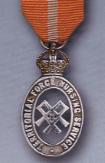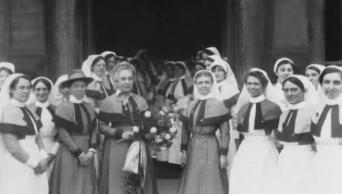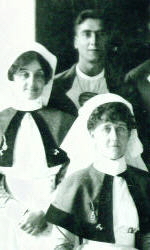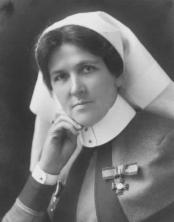THE TERRITORIAL FORCE NURSING SERVICE 1908-1921
AN OUTLINE
***
Prior to the Territorial and Reserve Forces Act of 1907, there had been no national medical or nursing service dedicated to the care of the volunteer army. The regular army had been supported by the Army Medical Service, together with Queen Alexandra's Imperial Military Nursing Service, who employed less than 300 nurses to provide nursing care in military hospitals at home and abroad. The Act made provision for the first time for both medical and nursing support to be available to the new force. Lord Haldane took the first steps in establishing the Territorial Force Nursing Service in March 1908, when he invited twelve women to form a Territorial Nursing Council; six were ladies of high standing, including his sister Elizabeth, and the other six were eminent London matrons. The new Matron-in-Chief of the service was Sidney Browne, who had retired from a similar position in QAIMNS in 1906, and the group met for the first time at the War Office on the16th June 1908 to discuss the steps to be taken to form a nursing service for the Territorial Force.[i]
There was provision for 23 territorial force hospitals in towns and cities throughout the country, each with planned accommodation for 520 patients. There was no accommodation for these units in peacetime, and they were to be housed in schools and other public buildings vacated by their residents at the time of mobilisation, and each with a staff of 91 trained nurses. To qualify for appointment as a sister or staff nurse in the TFNS, candidates had to be over 23 years of age and must have completed three years training in a recognised hospital or infirmary[ii], but as at that time women rarely started nurse training before the age of 23, the average age at joining was considerably higher than this.
Nursing in Great Britain was in a state of upheaval and there was a chronic shortage of fully trained nurses. During the first decade of the century some members of the Army Nursing Board were against any sort of military nursing service that recruited from the staff of civilian hospitals in peacetime. Sydney Holland, later Lord Knutsford, and Chairman of the London Hospital, was always opposed to a reserve – he felt that if the need arose there would be no difficulty in finding nurses for the Army, but to allow women to enrol as individuals in a military reserve could leave civilian hospitals in a difficult position in wartime, losing their most experienced staff to military service.[iii]
In July 1908 the service was inaugurated, draft proposals were published, and the enrolment of staff for the 23 hospitals began. Elizabeth Haldane, as vice-chairman of the Council, together with Alfred Keogh, toured Scotland and the provinces, holding meetings with the express aim of recruiting trained nurses for the TFNS. By March 1909 all four Scottish hospitals and 11 in England were up to establishment, and only London had made no move to staff its hospitals. This was, in part, due to the ongoing discord between senior nurses in the capital where there was still much opposition to a reserve, but in the spring of 1909 a Territorial Force Nursing Service committee began the process of selection of staff for the new service.[iv] A public meeting held at the Mansion House, London, on March 15th 1909, for the purpose of attracting interest in the TFNS, was attended by 600 nurses attached to London hospitals, with many well-known speakers including Lady Munro-Ferguson, Sir Alfred Keogh, Elizabeth Haldane, and Isla Stewart, the charismatic matron of St. Bartholomew’s Hospital.[v] The 400 nurses required were quickly recruited, but unlike the provincial hospitals where nurses could be drawn from many different training schools, No.1 (City of London) General Hospital was composed entirely of past and present members of the medical and nursing staff of Bart’s, and No. 2 (City of London) General Hospital, in similar fashion, drew it's staff only from Guy's and the London Hospitals.[vi] This practice was to continue throughout the following five years in the capital, resulting in a community of nurses bound tightly by the traditions of their training, a deep respect for their own hospital, and a unity that would carry them through the difficult times following mobilisation.

The new Territorial matrons were to spend 7 days training in a military hospital every second year, but the nurses who joined the TFNS would get neither pay nor special training during peacetime in return for their commitment. They were required to declare their intention to serve on January 1st of each year, while continuing to work in civilian hospitals and private homes, and it was felt that the high quality of their training, and their continued employment within the nursing profession would amply qualify them for military nursing without additional instruction. They each received a silver service badge, the design based on the ‘double A’ cipher of Queen Alexandra, which was to be worn on the right side of their dress or apron during the normal course of their civilian duty, with the permission of their employer. Other items of uniform which were not compulsory during peacetime were bought at their own expense, and worn at special functions when representing the Force. One of the most familiar of these was the small silver plated 'T' badge, worn diagonally at each corner of the shoulder cape, and which the Bart's nurses later joked were to indicate that they were 'Thoroughly Trained'![vii] One great advantage of these 'T's is that the uniform of the TFNS and the QAIMNS Reserve are very similar, and these ‘T’s have continued to be useful over the years to distinguish the two groups in black and white photographs.
In 1913 the TFNS was given permission for its members to volunteer for overseas service if not required for duty at home and at the outbreak of war there were 2,117 members of the service ready for mobilisation, and of the 23 territorial force hospitals, 19 were open and receiving casualties by the last day of August 1914, with the other 4 following by the end of September.[viii] The number of nurses in every field increased rapidly during the first six months of war, and continued to rise throughout the next four years in order to staff the ever growing number of military, auxiliary, Red Cross and private hospitals. Although traditionally, military nurses were required to be either single or widowed with no dependents, during wartime the extreme shortage of trained nurses meant that married women were welcomed into the TFNS, and if a serving nurse wished to marry, permission was normally granted for her to remain in the service. However, in 1920 all married women were required to resign, and the service reverted to one of single women – what was useful in war was not thought to be appropriate for peacetime.

The TFNS was originally formed to staff the territorial force hospitals at home, and the majority of its members spent their wartime service in the United Kingdom, not only in the 25 territorial hospitals[ix], but also in hundreds of auxiliary units throughout the British Isles. Within a short time they were also employed in the eighteen territorial hospitals abroad, and alongside their QAIMNS colleagues in military hospitals and casualty clearing stations in France, Belgium, Malta, Salonica, Gibralter, Egypt, Mesopotamia and East Africa. The figures for the actual number of women who served as trained members of the Territorial Force Nursing Service during the Great War varies with different sources, but the figure given by Ian Hay [Sir John Hay Beith] is 7,117, of whom 2,280 served overseas,[x] while Elizabeth Haldane gives a figure of 8,140 women who were part of the wartime TFNS, with the same number [2,280] serving abroad. Not all of these were serving at the same time, and in October 1918, shortly before the Armistice, there were 3,095 trained nurses of the service in military hospitals in the United Kingdom, with 1,964 in overseas stations.[xi] The National Archives’ run of records for the service, held in WO399, is known to be incomplete, and contains 6,439 individual files of women who served in the TFNS between 1914 and 1922.[xii]
After the Armistice some nurses chose to return to civilian life immediately, while others sought permanent employment within the military framework; but these jobs were scarce, and with several thousand nurses being demobilised from the QAIMNS Reserve, most of the women had returned to civilian employment by the middle of 1919. For many, the Territorial Force Nursing Service was to remain an important part of their lives, and wherever they were in the world they continued to register their wish to serve at the beginning of each year. In 1921, with reorganisation, the service expanded, and became the Territorial Army Nursing Service - in this form it would go forward into another war, and beyond.

FOOTNOTES
[i] The National Archives, WO32/21715, Formation of Territorial Force Nursing Service
[ii] The National Archives, WO32/21715
[iii] Anne Summers, Angels and Citizens [Routledge & Kegan Paul, London 1988], p. 238
[iv] Anne Summers, Angels and Citizens, p. 242
[v] The Times 16th March 1909, p. 9
[vi] St. Bartholomew’s Hospital League News, January 1909, p. 43
[vii] St. Bartholomew’s Hospital League News, January 1915, p. 545
[viii] The National Archives, WO222/1
[ix] In addition to the original 23 hospitals, No.5 London General [St. Thomas’] opened on the 16th August 1915, and No.2/1 Southern General, Birmingham, on the 1st June 1917.
[x] Ian Hay, One Hundred Years of Army Nursing [Cassell, London 1953], p. 337
[xi] Elizabeth S. Haldane, The British Nurse in Peace and War, [John Murray, London 1923], p. 179
[xii] The National Archives, WO399/9350 to WO399/15789
***